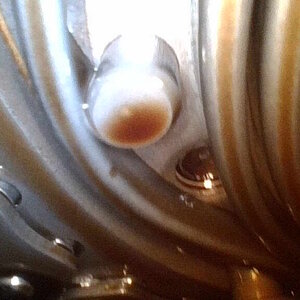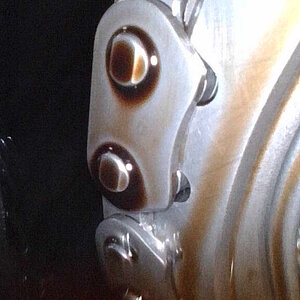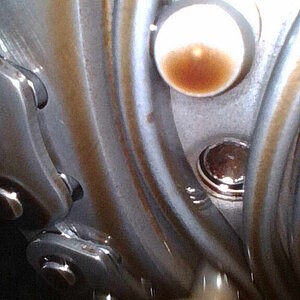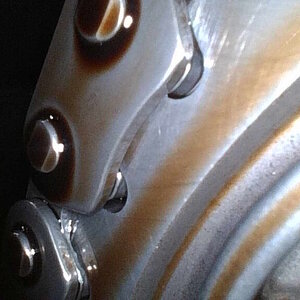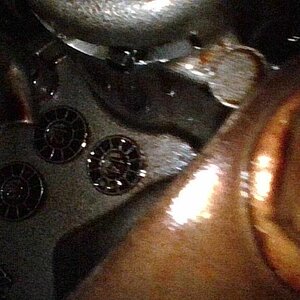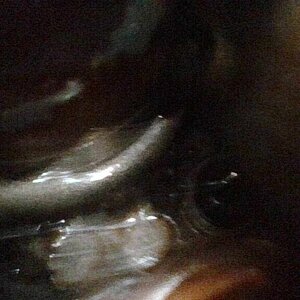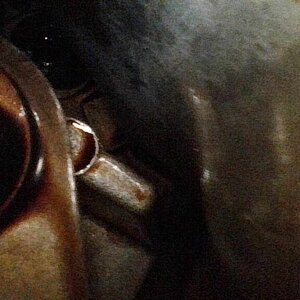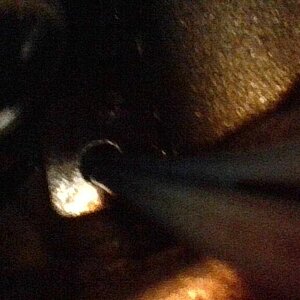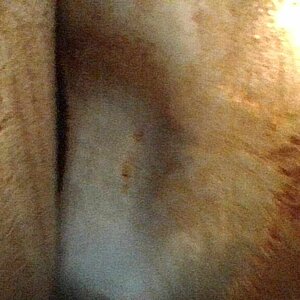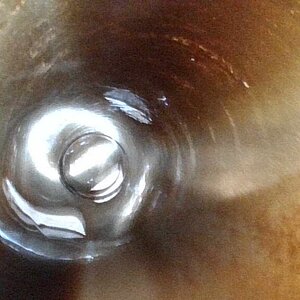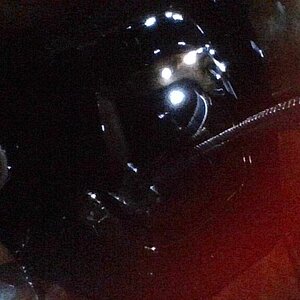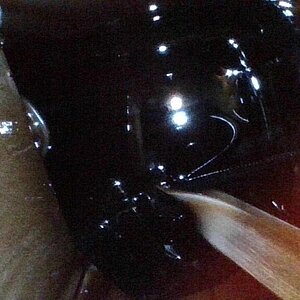This sample was pulled from my 2014 Dodge Durango with a total of 173,000 miles and 33,300 miles on the oil. I estimate the run time is 835 hours(33,300 miles/40 MPH). The oil is HPL's 5w-20 CK-4 based formula and has been run since Feb 9, 2022, about 23 months. The lab is Wearcheck. The usage on this 5,300 miles run was >75% high speed driving down the interstate. There was 3/4 quart of makeup oil. The PCV valve was changed and oil consumption returned to zero and the oil cooler was changed. Approximately 50% of the fuel used for this 5,300 mile was E-85. Fe wear rate for this 5,300 miles was 2ppm/1k miles. The TBN is still at 7.66 so plenty of alkalinity left. Without the makeup oil, we can extrapolate that the TBN would have been around 4.5, which is darn good for a run this long. Viscosity has increased to 13.2, which is well into the SAE 40 range (12.5-16.29). The Fe wear rate was almost exactly 1ppm/1k miles, which is outstanding.
I believe that this oil has reached it's useful life and will be changed. The condemnation limit of both viscosity and oxidation have been surpassed. @High Performance Lubricants suggests no more viscosity increase than 3 cSt, which is exactly where the viscosity is now. Wearcheck suggests an an oxidation limit of anything > 25, this oil is now at 27.1 (normalized).
[edit added Jan 6, 2024]
This is the oil filter run for the previous 5k miles. I was able to scrape agglomerated material off the filter, a 3cSt increase in viscosity, and normalized oxidation value of 27. The data is telling us that we have found the limit of this oil. The oil has been changed with 6.5 fresh quarts of HPL HDEO 5w-20 and a Fram Endurance filter. I will use the same methodology to determine how long the next run will be.

The air filter was changed with 43k miles of run time. The Si was ticking up during this OCI and it could be that the air filter had too much time. When I removed the filter, I noticed the clean side of the air box was not perfectly clean. Either this air filter let some dirt into the engine or the installer (me) didn't get a tight seal.

A bit of metallic material stuck to the drain plug magnet:

[end edit]
One of my reasons for running this oil out so far was to validate what HPL claims about their engine oils. The claim is that their oils are formulated for extended drains. When I asked David Ward how far can the OCI with these oils be extended? His answer was, "longer than you will be comfortable". Challenge accepted. I put all feelings aside and strictly used data from UOAs and took some pictures inside the engine to check the cleanliness. You have seen the results. In the future I will likely do a UOA every 10k miles, instead of 5k miles. I feel completely confident that I could sample at 20k miles and 30k miles, but will also sample at 10k, because I like data.
Fleets extend oil drains because they save money, which equates to making more profit. I am not a fleet, but did gain on several points. Why change oil when data shows it's not necessary? It seems like a waste of resources and money to throw good oil away. I do not really enjoy crawling under the car to change oil. I did save money by extending this OCI and will save more by reducing the frequency of UOAs.
When I change the oil, I will post more internal pictures taken with my bore scope.
Previous UOA:
Oil cooler change thread:
Under valve cover pictures:
Sump pictures after oil was drained:
Data:
I believe that this oil has reached it's useful life and will be changed. The condemnation limit of both viscosity and oxidation have been surpassed. @High Performance Lubricants suggests no more viscosity increase than 3 cSt, which is exactly where the viscosity is now. Wearcheck suggests an an oxidation limit of anything > 25, this oil is now at 27.1 (normalized).
[edit added Jan 6, 2024]
This is the oil filter run for the previous 5k miles. I was able to scrape agglomerated material off the filter, a 3cSt increase in viscosity, and normalized oxidation value of 27. The data is telling us that we have found the limit of this oil. The oil has been changed with 6.5 fresh quarts of HPL HDEO 5w-20 and a Fram Endurance filter. I will use the same methodology to determine how long the next run will be.
The air filter was changed with 43k miles of run time. The Si was ticking up during this OCI and it could be that the air filter had too much time. When I removed the filter, I noticed the clean side of the air box was not perfectly clean. Either this air filter let some dirt into the engine or the installer (me) didn't get a tight seal.
A bit of metallic material stuck to the drain plug magnet:
[end edit]
One of my reasons for running this oil out so far was to validate what HPL claims about their engine oils. The claim is that their oils are formulated for extended drains. When I asked David Ward how far can the OCI with these oils be extended? His answer was, "longer than you will be comfortable". Challenge accepted. I put all feelings aside and strictly used data from UOAs and took some pictures inside the engine to check the cleanliness. You have seen the results. In the future I will likely do a UOA every 10k miles, instead of 5k miles. I feel completely confident that I could sample at 20k miles and 30k miles, but will also sample at 10k, because I like data.
Fleets extend oil drains because they save money, which equates to making more profit. I am not a fleet, but did gain on several points. Why change oil when data shows it's not necessary? It seems like a waste of resources and money to throw good oil away. I do not really enjoy crawling under the car to change oil. I did save money by extending this OCI and will save more by reducing the frequency of UOAs.
When I change the oil, I will post more internal pictures taken with my bore scope.
Previous UOA:
Dodge Durango 3.6L - HPL CK-4 5w-20 - 28,000 miles on oil - 168,000 miles total
This sample was pulled from my 2014 Dodge Durango with a total of 168,000 miles and 28,000 miles on the oil. The oil is HPL's 5w-20 CK-4 based formula and has been run since Feb 9, 2022, about 21 months. The lab is Wearcheck. The usage on this 9,300 mile run was >75% high speed driving down the...
bobistheoilguy.com
Oil cooler change thread:
New Dorman oil filter housing/oil cooler installed on 2014 Durango
For context, this is the thread I posted earlier about the leaking oil cooler. https://bobistheoilguy.com/forums/threads/durango-oil-filter-cooler-housing-leaking-again.375626/ I changed the filter housing/oil cooler this morning. The job from start to finish took about 4 hours and 15 minutes...
bobistheoilguy.com
Under valve cover pictures:
Sump pictures after oil was drained:
Dodge Durango 3.6L 174k miles total 34k miles on oil - sump pictures
- wwillson
- 23
Bore scope inserted through drain plug hole taking a look around.
Data:
| Sample Information | ||||||||||||
| Sample Date | Feb 2020 | Dec 2020 | March 2021 | August 2021 | October 2021 | February 2022 | March 15, 2022 | September 5, 2022 | April 19, 2023 | June 13, 2023 | October 28, 2023 | January 1, 2024 |
| Machine Age miles | 116,000 | 122,200 | 127,420 | 132,679 | 137,615 | 140,000 | 141,500 | 147,000 | 152,000 | 158,700 | 168,000 | 173,300 |
| Oil Age miles | 5,000 | 11,200 | 15,820 | 21,079 | 26,015 | 2,500 | 1,500 | 7,000 | 12,000 | 18,700 | 28,000 | 33,300 |
| Makeup oil quarts | 0.75 | |||||||||||
| Filter Age miles | 5,000 | 11,200 | 15,820 | 21,079 | 4,936 | 2,500 | 1,500 | 2,000 | 5,000 | 6,700 | 5,000 | 5,000 |
| Oil Changed | no | no | no | no | yes | yes | yes | no | no | no | no | yes |
| Filter Changed | no | no | no | yes | yes | yes | yes | yes | yes | yes | yes | yes |
| Brand | HPL | HPL | HPL | HPL | HPL | HPL | HPL | HPL | HPL | HPL | HPL | HPL |
| Viscosity | 5w-20 HDEO | 5w-20 HDEO | 5w-20 HDEO | 5w-20 HDEO | 5w-20 HDEO | 5w-20 HDEO | 5w-20 HDEO | 5w-20 HDEO | 5w-20 HDEO | 5w-20 HDEO | 5w-20 HDEO | 5w-20 HDEO |
| new formula | new formula | |||||||||||
| Wear Metals | ||||||||||||
| Iron | 5 | 13 | 21 | 42 | 62 | 19 | 6 | 9 | 15 | 17 | 23 | 33 |
| Chromium | <1 | <1 | <1 | 2 | 2 | <1 | <1 | <1 | <1 | <1 | 1 | 2 |
| Nickel | 0 | 0 | 0 | <1 | 0 | 0 | <1 | 0 | 0 | <1 | <1 | <1 |
| Titanium | <1 | <1 | <1 | <1 | 2 | <1 | <1 | <1 | 0 | <1 | <1 | <1 |
| Silver | <1 | <1 | <1 | <1 | <1 | <1 | 0 | <1 | 0 | 0 | 0 | 0 |
| Aluminum | 3 | 3 | 1 | 5 | 5 | 4 | 2 | 4 | 1 | 5 | 8 | 12 |
| Lead | 0 | 0 | <1 | 1 | <1 | 1 | 1 | 0 | 0 | 0 | 3 | <1 |
| Copper | 3 | 10 | 16 | 39 | 66 | 64 | 31 | 65 | 72 | 69 | 64 | 65 |
| Tin | 0 | <1 | 0 | <1 | <1 | <1 | <1 | 0 | 0 | 0 | <1 | <1 |
| Antimony | 0 | 0 | <1 | <1 | - | - | - | - | - | - | - | - |
| Vanandium | <1 | <1 | 0 | <1 | <1 | <1 | 0 | <1 | 0 | <1 | <1 | <1 |
| Cadmium | 0 | 0 | 0 | <1 | not reported | 0 | 0 | 0 | 0 | 0 | 0 | 0 |
| Additives | ||||||||||||
| Boron | 181 | 81 | 42 | 43 | 23 | 20 | 2 | 2 | 0 | 0 | 1 | 16 |
| Barium | 3 | 0 | 1 | 0 | 2 | 0 | 0 | 0 | 0 | 4 | 1 | 0 |
| Molybdenum | 523 | 521 | 500 | 518 | 545 | 535 | 492 | 548 | 600 | 590 | 494 | 573 |
| Manganese | <1 | <1 | <1 | 2 | 3 | 1 | <1 | <1 | <1 | <1 | <1 | 2 |
| Magnesium | 462 | 446 | 430 | 467 | 461 | 1078 | 1091 | 981 | 1158 | 1059 | 998 | 1131 |
| Calcium | 3422 | 3237 | 3203 | 3379 | 3562 | 2812 | 2431 | 2458 | 2767 | 2645 | 2340 | 2637 |
| Phosphorus | 788 | 777 | 760 | 754 | 802 | 1137 | 1094 | 1024 | 1095 | 1041 | 855 | 1089 |
| Zinc | 948 | 924 | 884 | 949 | 988 | 1326 | 1176 | 1271 | 1411 | 1271 | 1129 | 1404 |
| Contaminants | ||||||||||||
| Silicon | 11 | 11 | 15 | 25 | 33 | 17 | 12 | 13 | 18 | 17 | 20 | 22 |
| Sodium | 4 | 4 | 5 | 8 | 8 | 4 | 0 | 3 | 5 | 4 | 16 | 19 |
| Potassium | 1 | <1 | 2 | 3 | 4 | 1 | 0 | 2 | 2 | 3 | 4 | 3 |
| Fuel % | <1.0 | <1.0 | <1.0 | <1.0 | <1.0 | <1.0 | <1.0 | <1.0 | <1.0 | <1.0 | <1.0 | <1.0 |
| Glycol | NEG | NEG | NEG | NEG | NEG | NEG | NEG | NEG | NEG | NEG | NEG | NEG |
| Soot% | 0.1 | 0.1 | 0.1 | 0.1 | 0.1 | 0.1 | 0.1 | 0.1 | 0.1 | 0.1 | 0 | 0.1 |
| Fluid Condition | ||||||||||||
| TBN | 12.3 | 7.3 | 5.05 | 3.985 | 2.85 | 12 | 16.8 | 10.8 | 9.28 | 8.11 | 6 | 7.76 |
| Viscosity | 8.8 | 9.1 | 9.4 | 9.56 | 10.6 | 9.2 | 9.4 | 10 | 10.4 | 11.6 | 12.6 | 13.2 |
| Oxidation | 5 | 15.3 | 22.5 | 24.1 | 31 | 45.3 | 0 (39.7) | 12(51.7) | 14.3(54.0) | 21(60.7) | 24.4(64.1) | 27.1(66.8) |
Last edited:



